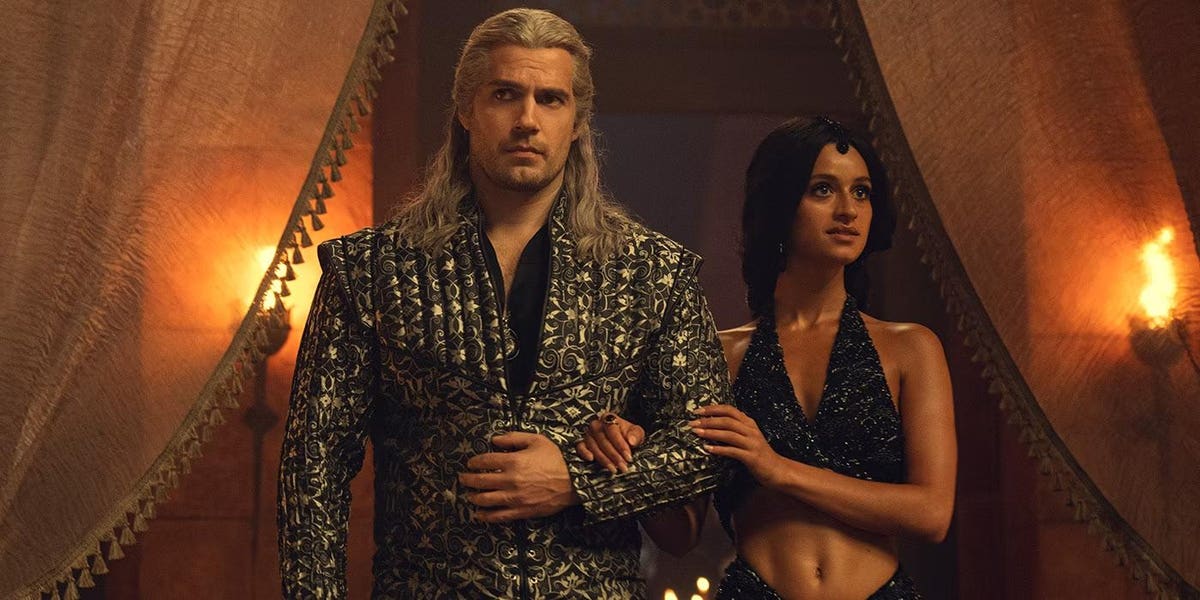Season 3 of The Witcher has some good moments and sticks a bit closer to the source material than Season 2, but overall it’s a bit of a mess in its first five episodes. The show released in two parts, with five episodes landing this week and another three coming out in late July.
I think I’d be a little more forgiving of the season so far if it weren’t for Episode 5, ‘The Art Of Illusion’ which fails in both artistic terms and in creating an effective illusion. In fact, the episode fails in almost every conceivable way, and is by far the worst episode of The Witcher Netflix has aired up to this point.
Some spoilers ahead.
The episode takes place at a ball that’s kicking off a conclave of mages on Thanned island (where Aretuza is located) after Yennefer quite easily finds her way back into the Brotherhood’s good graces. She implores upon her fellow sorceresses and wizards to look past their differences and work together to save the Northern Kingdoms from the Nilfgaardian empire (a threat the show still has done an extremely poor job explaining to viewers).
Structurally, the episode jumps back and forth between after the ball, as Geralt (Henry Cavill) and Yennefer (Anya Charlota) make love (rather tamely) and then lay about reminiscing on how well the ball went. “An almost perfect evening,” Yen says.
In fact, she says this more than once. Most of the dialogue in the episode is repeated two or three times (possibly more) because the structure of the episode doesn’t just jump back to different moments during the ball, but to different angles. So in one scene, we see part of the dialogue between Geralt and another character as they look down on Yen conversing with other mages below. We don’t hear what Yen is saying.
Later, however, we get to see the other perspective and get a glimpse of events from a different perspective.
This is all fine. I don’t mind an episode toying with structure this way, hopping back and forth, revealing little bits and pieces as we go. Christopher Nolan employs this trick in his films. The problem is with the episode’s absolutely astonishingly awful editing and direction. Instead of bouncing back to an event in the ball and giving us maybe one line we’ve already heard before showing us the new angle, we’re often forced to sit through entire scenes repeated. The same dialogue, the same shots, etc. until finally they move on to the new bits we haven’t seen yet.
It’s bizarre. I’ve never seen anything like it. I’ve seen TV and movies employ this structure before. It can be fascinating when you think you know what happened, but then discover later that you’ve only seen half the truth. When these new details fundamentally change your perspective on events, it can be a pretty exciting way to tell a story. But this constant repetition, showing us the same scenes and the same dialogue over and over again is tedious and confusing.
Worse, the twists and turns were all wildly obvious. The whole evening, Yen, Geralt, Triss and Istredd believe that the wizard Stregobor—a notorious racist and sexist old bugger—is behind the scheming they’re trying to uncover. But they come to this so early on, and pursue it with such certainty, that’s wildly obvious that Stregobor is just a red herring.
Meanwhile, from the moment Vilgefortz gave Tissaia the bracelet earlier in the season—and then they kept showing the bracelet, over and over again—it was obvious that he was the villain behind everything. My colleague Paul Tassi joked with me that it was a Chekov’s bracelet.
Of course, worse still, it’s been quite clear that Vilgefortz was a villain since the end of Season 1 and the Battle of Sodden Hill when he killed one of his fellow mages for no obvious reason—after the mage had defeated a whole contingent of Nilfgaardian troops. (Around the 41 minute mark in Season 1, Episode 8 if you’re curious). From this point on it’s been obvious that Vilgefortz was a villain, tricking his own compatriots and working at some dark purpose. I never questioned once that he would be the secret sponsor of the fire mage Rience.
But even if that was something most viewers forgot or hadn’t clued into, the bad editing and far, far too obvious red herrings and other clues made the twist at the end way too obvious and while most of the episode plodded along, Yen and Geralt’s lightbulb moment at the end felt rushed.
Oh, and the song that new bard Valdo Marx was playing made me roll my eyes. Repeatedly, since it kept playing over and over again. “All is not as it seems,” the troupe sings. Please, lay it on a little thicker next time, won’t you? I didn’t realize.
So obviously much of this cannot be fixed. It’s too late. The damage has been done. Season 2 ensured that any redemption arc for this show would be all but impossible. But one thing can be fixed, quite easily, and in the age of streaming Netflix should absolutely do it.
The editing—all those repeated scenes—could be revisited. All the extraneous repetition could be shaved down. You could still keep some establishing dialogue to anchor us to the point we’re leaping back to, but then just cut—CUT CUT CUT—everything else until we get to the relevant new scene. This would make the episode move along at a much better pace and make it less confusing for viewers, many of whom I imagine thought the episode had just started over a couple times in the middle. That’s how bad the editing is here. It feels like a technical glitch.
And it can be fixed. Netflix could fix it and reupload the fifth episode. They can do it and they should do it. It won’t save the season, but it sure will make that episode more palatable.
You can read my Season 3, Part 1 review right here.
What are your thoughts? Let me know on Twitter or Facebook.
Read the full article here




